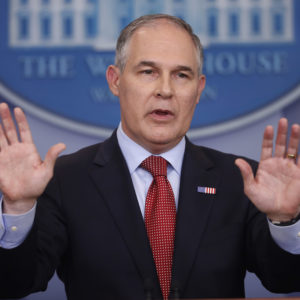When EPA Administrator Scott Pruitt took over as head of America’s top environmental regulation body a year ago, he pledged to reform the institution. According to Pruitt, the EPA needed to go “back to the basics,” shifting from a regulate-and-fine model to one that worked towards cooperation with state level agencies with the goal of increasing compliance. A new report from the EPA shows how far the agency has come over the last year, as it shifts its approach to environmental regulation towards that stresses compliance and industry growth. Over the course of 2017, the EPA finalized 22 “deregulatory actions,” which it predicts saved Americans $1 billion in environmental regulation costs.
“We have made tremendous progress in year one to implement the president’s vision,” wrote Pruitt. “EPA today is more efficient, more effective and more transparent in carrying out its all-important task of protecting human health and the environment.”
As a new administrator, Pruitt explained a series of areas where he wanted the agency to improve, highlighting regulatory backlogs in chemical approvals, a lengthy list of Superfund sites, and the EPA’s often adversarial relationship with state environmental agencies. Some of these areas have seen dramatic progress. Over the course of 2017, the EPA cleared its backlog of 600 new chemicals submitted for approval and worked to ensure that future chemical submissions will be reviewed within roughly 90 days.
The EPA also successfully fully or partially removed seven sites from the Superfund list. These included Nutting Truck & Caster Co. in Minnesota, Shpack Landfill in Massachusetts, and the Perdido groundwater contamination site in Alabama, which were all completely removed from the list. Sites in Pennsylvania, Nebraska, and Wyoming were partially removed.
So-called “deletion” rates on the list vary from year to year. In 2016, the EPA only removed two sites from the list of around 1,300, but in 2015, seven sites were taken off of the list, and in 2014, 15 were.
Some of the most controversial changes at the EPA came in its regulatory policies. In 2017, the EPA rolled back several major Obama-era policies, such as the Clean Power Plan and the “Water of the U.S.” rule, which significantly increased federal oversight of rivers, lakes, streams, and marshes. It also changed its approach to working with state-level environmental officials.
On issues of air and water quality, Pruitt’s EPA has worked with states to ensure that more areas of the country are found in compliance. Soon after taking office, Pruitt expressed his disappointment that roughly 40 percent of the nation lives in areas where the air quality does not meet standards set under the National Ambient Air Quality Standards (NAAQS.) At the end of 2017, Pruitt announced that 85 percent of the country met stringent standards for ozone levels.
The EPA also shifted in its approval processes to drastically cut the time it takes to review state level standards. For example, last year, the agency halved the time it takes to review state water quality standards to 60 days. It also shifted the responsibility for improving air quality from top-down, federally-imposed mandates to state-level regulation. During the Obama administration, the EPA imposed 50 federal implementation plans on states. Under Pruitt’s watch, one federal plan has been turned into a state plan each month, on average.
Internally, Pruitt reformed the EPA’s litigation approach by clamping down on the use of “sue and settle.” Previously outside environmental groups had used lawsuits to try to pressure the EPA into issuing a consent decree or settlement agreement agreeing to additional regulatory obligations. Through this process, environmental activists had successfully established agency environmental regulation obligations without the participation of either elected representatives or the industries being regulated. As administrator, Pruitt issued a directive to avoid these types of settlements.
At the same time, EPA fines have not gone away under Pruitt’s watch. In fact, the EPA celebrated an increase in criminal fines, restitution, and mitigation payments, collecting $1.6 billion in administrative and civil judicial penalties during FY2017. Leaving out Volkswagen’s $5.7 billion fine last year for its emissions test tampering, the $1.6 billion in fines is more than the agency has collected in a decade.

